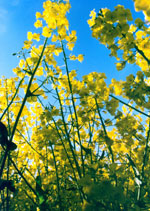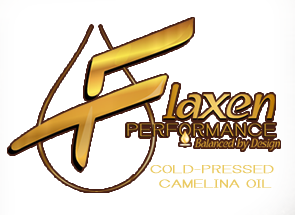WHAT IS FLAXEN PERFORMANCE?
Flaxen Performance is a PURE and BENEFICIAL pressed oil supplement from the Camelina Sativa plant.


HISTORY of CAMELINA OIL
Camelina sativa, usually known in English as camelina, gold-of-pleasure, or false flax, also occasionally wild flax, linseed dodder, German sesame, and Siberian oilseed, is a flowering plant in the family Brassicaceae which includes mustard, cabbage, rapeseed, broccoli, cauliflower, kale, brussels sprouts. It is native to Northern Europe and to Central Asian areas, but has been introduced to North America, possibly as a weed in flax.
It has been traditionally cultivated as an oilseed crop to produce vegetable oil and animal feed. Ample archeological evidence shows it has been grown in Europe for at least 3,000 years. The earliest findsites include the Neolithic levels at Auvernier, Switzerland (dated to the second millennium BC), the Chalcolithic level at Pefkakia in Greece (dated to the third millennium BC), and Sucidava-Celei, Romania (circa 2200 BC). During the Bronze age and Iron age, it was an important agricultural crop in northern Greece beyond the current range of the olive. It apparently continued to be grown at the time of the Roman Empire, although its Greek and Latin names are not known. According to Zohary and Hopf, until the 1940s, C. sativa was an important oil crop in eastern and central Europe, and currently has continued to be cultivated in a few parts of Europe for its seed oil, which was used, for example, in oil lamps (until the modern harnessing of natural gas and propane and electricity) and as an edible false flax oil.
- Archeological excavation proves its existance in the Bronze age(1500-400 B.C) and Iron Age(400 B.C-500 A.D) in Europe, Russia and Scandinavia.
- Iron Age-Cultivation of camelina doubles in Europe as a source of edible oil.
- Beginning of 20th century to 1930's: Cultivation in France, Belgium, Holland and Russia continued.
- New oil crops such as olive, sunflower, canola took over the land in competition with camelina.
- Camelina is emerging as a "new crop" today in America
ATTRIBUTES
Excellent source of omega 3 fatty acids(35-40%).
Camelina Oil can be used as an edible oil, animal feed, and biofuel (CFIA 2012). The seeds are 45% oil and are particularly high in alpha-linolenic acid, which gives it an added health advantage over other oilseed crops (Kirkhus et al. 2013). Camelina is also rich in tocopherols, which helps it resist oxidation and have a long, stable shelf life (Kirkhus et al. 20013). Outside of these major uses, camelina oil has been used for cosmetics, varnishes, and stalks can be used for pulp fiber and upgraded products (Zubr 2003). Camelina is well adapted to organic agriculture because it is naturally resistant to many pests and is a low nutrient user. Thus pesticides, herbicides, and fertilizers do not need to be applied, in order to produce excellent yields.
- High Vitamin E content
- Oxidative stable and palatable(475° smoke point)
- 18 month shelf life
- 33-38% oil content in seeds
- 40% protein content in meal byproduct
- Good yields of 1,000 lbs/Acre in Ritzville.
Nutritional benefits for Human Consumption
- 2:1 ratio of omega 6's to omega 3's
- 15:1 ratio of average western diets
- Omega 3's help reduce heart disease, CVD, inflammation and cancer.
- Camelina oil can help reduce cholesterol and triglycerides with those that have high levels.
- High in natural antioxidants to fight off free radicals.
- Camelina oil has certain therapeutic and healing properties. [1]
- Antioxidant – Camelina oil is a strong antioxidant because of the high Vitamin E content.
- Emollient – It moisturizes the skin.
- Anti-Inflammatory – It strongly inhibits inflammation both topically and when used internally.
- Anti-arthritic – Because of its high omega – 3 content, it can be used to alleviate pain in arthritis.
- Hair Conditioner – It can be used as a hot oil treatment for hair.
- Immune booster – Because of the high Vitamin E content, it boosts the immune system.
Color, Taste and Aroma
Camelina oil has a golden, somewhat olive oil like color. Surprisingly, it tastes like almond oil. Its aroma is herbaceous with some nutty tones.
Good taste, thus facilite the intake by the horse, dog and human.
Easy to store, keep it for a long time without refrigeration
Well balanced, due to it's composition, is an excellent source of omega-3
Typical meal analysis:
• Crude Protein...42%
• Crude Fat……...13%
• Moisture………...8%
• Fiber……………10%
• Ash……………..5.5%
Benefits: Healthy Joints, Heart, Skin and Immune System
Promotes healing with a proper balance of Omega 3, 6, and 9
FATTY ACID PROFILE
(reported as precent of total fat)
Omega-3 Fat……………34.2%
Omega-6 Fat……………19.8%
Omega-9 Fat……………16.2%
Vitamin E (tocopherols)…254ug/g
Peroxide Value…………3.97%
CAMELINA OIL
Camelina Sativa (L.) Crantz., Brassicaceae (falsflax, linseed dodder, or gold-of-pleasure) originated in the Mediterranean to Central Asia. The plant is an annual, of Winter annual. Seeds are small (0.7mm x 1.5mm), pale yellow-brown, oblong and rough with a rigid surface. Camilina oil is obtained by cold pressing from the seeds of Camelina Sativa. Camelina Sativa is a golden oil with flowery odor and pleasant taste. Early oil research has demonstrated considerable shelf-life stability over flax and fish oil that has a very palatable taste.
Additional Nutritional Info
The crop is now being researched due to its exceptionally high levels (up to 45%) of omega-3 fatty acids, which is uncommon in vegetable sources.
Over 50% of the fatty acids in cold pressed camelina oil are polyunsaturated. The major components are alpha-linolenic acid – C18:3 (omega-3-fatty acid, about 35-45%) and linoleic acid – C18:2 (omega-6 fatty acid, about 15-20%). The oil is also very rich in natural antioxidants, such as tocopherols, making this highly stable oil very resistant to oxidation and rancidity. It has 1 – 3% erucic acid. The vitamin E content of Camelina oil is approximately 110 mg/100g. It is well suited for use as a cooking oil. It has an almond-like flavor and aroma.
The traditional Polish camelina oil is included in the EC register of traditional specialities guaranteed as Olej rydzowy.
Because of its potential health benefits and its technical stability, Camelina oil or gold-of-pleasure and camelina oil are being added to the growing list of foods considered as functional foods which is demonstrated to have physiological benefits and/or reduce the risk of chronic disease beyond basic nutritional functions, i.e. they contain bioactive compound.
human health benefits
Camelina oil offers brilliant nutrition. Along with this, its healing properties make it useful for a number of conditions.
1. Camelina oil for Skin
Camelina oil can be used as a massage oil for the skin. Because it has a nice mild aroma, it feels good during the massage. It provides ample amount of Vitamin E and omega fatty acids directly to the skin. These moisturize the skin and prevent it from free radical damage. One can perform this massage regularly to get healthier, smooth and well moisturized skin.
2. Camelina oil for Hair
Camelina oil can be used just like olive oil for a hot oil scalp massage. This provides nutrition to the scalp and gets rid of dry skin, dandruff and flakiness. It can help to keep the hair looking soft and moisturized. Its antioxidants protect the hair shafts from free radical damage.
3. Omega – 3
Camelina oil provides about 4 gm of omega – 3 in a single tablespoon.It can be used as a substitute for flaxseed oil for getting omega-3 in diet.
One can simply get the omega-3 by using camelina oil as a salad oil. It has got a nice taste and goes well with foods.
4. Heart Health
Camelina oil lowers blood triglyceride levels. This is good for cardiovascular health as it reduces the risk of heart diseases.
5. Arthritis
Camelina oil can be applied topically to reduce inflammation in arthritis. When taken internally, it provides large amounts of omega – 3 fatty acids. Regular intake of omega- reduces overall inflammation. One can experience a reduction in pain, inflammation and swelling over the joint. It also boosts mobility in the joint. Camelina oil can be used as a carrier oil. It goes well with rosemary essential oil and this combination can be massaged on the inflamed joint.
6. Good for the Brain, Eyes and Nerves
Foods rich in omega-3 fatty acids,like alpha linoleic acid, EPA and DHA are helpful in keeping the brain, eyes and nerves healthy. As a result, camelina oil may protect against cognitive diseases, like dementia, Alzheimer's, eye diseases like macular degeneration and nervous damage due to inflammation.
Side effects, Safe Dosage and Toxicity Issues
There are no known side effects of camelina oil.
Further Research
http://www.siberiantigernaturals.com/camelinaoil.htm
http://oilhealthbenefits.com/camelina-oil/
References:
2. Camelina oil and its unusual cholesterol content V. K. S. Shukla, P. C. Dutta, W. E. Artz. Journal of the American Oil Chemists' Society
3. Some compositional properties of camelina (camelina sativa L. Crantz) seeds and oils. John T. Budin, William M. Breene, Daniel H. Putnam
For educational purposes only. This information has not been evaluated by the Food and Drug Administration.
This information is not intended to diagnose, treat, cure, or prevent any disease.






